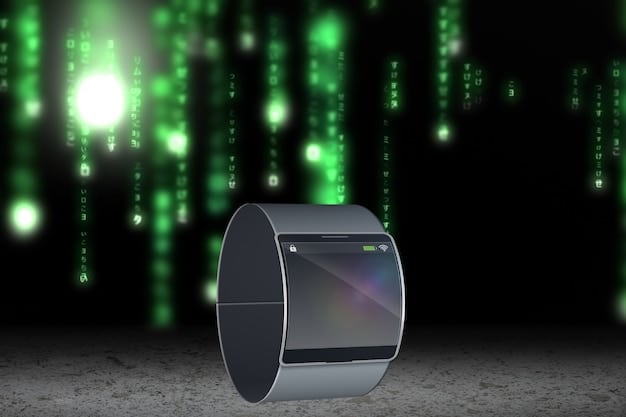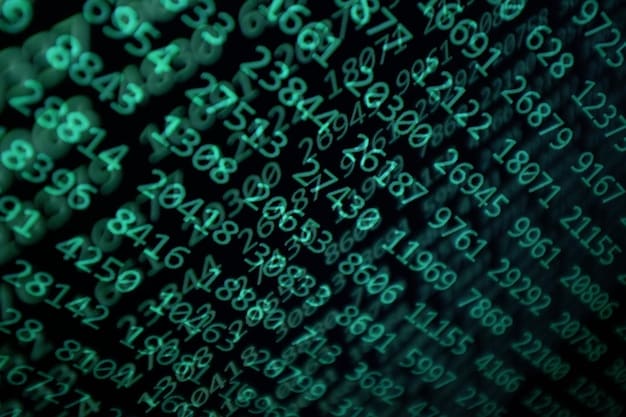Altcoin Wallet Security: Protect Your Crypto from Hacks in 2025

Altcoin wallet security is paramount in 2025; safeguarding your digital assets from hacks requires a proactive, multi-layered approach, including robust password management, enabling two-factor authentication, and keeping software updated.
In the ever-evolving landscape of cryptocurrency, securing your altcoins is more critical than ever. This comprehensive guide on altcoin wallet security: a step-by-step guide to protecting your investments from hacks in 2025 will equip you with the knowledge and strategies needed to safeguard your digital assets.
Understanding the Threat Landscape for Altcoin Wallets
The world of altcoins offers exciting opportunities for investment, but it also attracts malicious actors looking to exploit vulnerabilities. Understanding the types of threats that target altcoin wallets is the first step in establishing robust security measures.
Common Hacking Techniques Targeting Altcoins
Hackers employ a variety of techniques to compromise altcoin wallets. These range from sophisticated phishing attacks to exploiting vulnerabilities in wallet software. Awareness of these methods is crucial for prevention.
- Phishing Attacks: Deceptive emails or websites trick users into revealing their private keys or seed phrases.
- Malware: Malicious software installed on a user’s device can steal wallet information or control the wallet directly.
- Keyloggers: Software that records keystrokes, capturing passwords and other sensitive data.
- Clipboard Hijacking: Malware that replaces the intended recipient address with the hacker’s address when copying and pasting crypto addresses.
Staying informed about these tactics allows you to anticipate and avoid potential threats.

Beyond these methods, it’s essential to understand how hackers target specific vulnerabilities in different altcoin wallets. Some wallets may have weaknesses in their encryption or authentication processes, making them more susceptible to attack. By researching the specific security features and known vulnerabilities of your chosen wallet, you can tailor your security measures accordingly.
In conclusion, understanding the threat landscape requires constant vigilance and staying informed about the latest hacking techniques. This knowledge is the foundation for building a strong defense against potential attacks on your altcoin wallets.
Choosing the Right Altcoin Wallet for Security
Not all altcoin wallets are created equal when it comes to security. Selecting a wallet with robust security features is crucial for protecting your digital assets. Understanding the different types of wallets and their security strengths and weaknesses will help you make an informed decision.
Hardware vs. Software Wallets: A Security Comparison
Hardware and software wallets offer different levels of security. Hardware wallets are generally considered more secure as they store private keys offline, minimizing the risk of compromise.
- Hardware Wallets: Physical devices that store private keys offline, offering superior protection against online threats.
- Software Wallets: Applications installed on computers or smartphones, offering convenience but greater vulnerability to malware and hacking.
- Multi-Sig Wallets: Require multiple approvals for transactions, adding an extra layer of security.
For long-term storage of significant altcoin holdings, a hardware wallet is generally the recommended choice.
Software wallets, while convenient, require careful consideration. Look for wallets that offer features like two-factor authentication (2FA), encryption, and a strong reputation for security. It’s also important to keep your software wallet updated to patch any known vulnerabilities.
Key Features to Look for in a Secure Altcoin Wallet
When choosing an altcoin wallet, prioritize features that enhance security and protect your digital assets.
Consider wallets with features such as multi-signature support, which requires multiple authorizations for transactions, and cold storage options for securing a portion of your holdings offline. Look for wallets with open-source code that has been audited by security professionals.
In summary, selecting the right altcoin wallet is a critical step in securing your digital assets. Consider your individual needs and risk tolerance, and choose a wallet with robust security features and a proven track record.
Implementing Strong Password Management
A strong, unique password is your first line of defense against unauthorized access to your altcoin wallets. Effective password management is essential for securing your digital assets. Weak or reused passwords are a common vulnerability that hackers exploit.
Creating Strong, Unique Passwords for Each Wallet
Avoid using easily guessable passwords, such as your name, birthday, or common words. A strong password should be at least 12 characters long and include a mix of uppercase and lowercase letters, numbers, and symbols.
Use a password manager to generate and store strong, unique passwords for each of your altcoin wallets. Avoid reusing passwords across multiple accounts. If one password is compromised, all accounts using that password become vulnerable.

Regularly update your passwords, especially if you suspect a security breach or have been notified of a potential vulnerability. Implement a password rotation policy to ensure that your passwords remain secure over time.
In conclusion, by prioritizing strong, unique passwords and utilizing password management tools, you can significantly enhance the security of your altcoin wallets and reduce the risk of unauthorized access.
Enabling Two-Factor Authentication (2FA)
Two-factor authentication adds an extra layer of security to your altcoin wallets by requiring a second verification method in addition to your password. This makes it significantly more difficult for hackers to gain unauthorized access to your account.
How 2FA Protects Your Altcoins From Unauthorized Access
2FA works by requiring a code generated by a separate device, such as your smartphone, in addition to your password. Even if a hacker obtains your password, they will not be able to access your account without the second verification code.
Enable 2FA on all your altcoin wallets and exchanges that support it. Choose a 2FA method that is secure and reliable, such as authenticator apps like Google Authenticator or Authy. Avoid using SMS-based 2FA, as it is vulnerable to SIM swapping attacks.
- Authenticator Apps: Generate time-based codes for verification, offering a secure and convenient 2FA method.
- Hardware Security Keys: Physical devices that provide a strong form of 2FA, protecting against phishing and other online attacks.
Back up your 2FA recovery codes in a safe place in case you lose access to your primary 2FA device. These codes will allow you to regain access to your account if your device is lost or stolen.
In conclusion, enabling 2FA is a critical step in securing your altcoin wallets. It provides an extra layer of protection against unauthorized access, even if your password is compromised. By choosing a secure 2FA method and backing up your recovery codes, you can significantly enhance the security of your digital assets.
Securing Your Devices and Network
Your computer, smartphone, and internet network are potential entry points for hackers targeting your altcoin wallets. Securing these devices and networks is essential for protecting your digital assets. Vulnerable devices and networks can expose your private keys and other sensitive information.
Protecting Your Computer and Smartphone From Malware
Install and maintain reputable antivirus and anti-malware software on your computer and smartphone. Regularly scan your devices for malware and remove any detected threats.
Keep your operating system and software applications up to date to patch any known vulnerabilities. Enable automatic updates to ensure that your devices are always protected against the latest threats.
- Use Strong Antivirus Software: Provides real-time protection against malware and other threats.
- Keep Software Updated: Patches vulnerabilities and enhances security.
Avoid clicking on suspicious links or downloading files from untrusted sources. Be wary of phishing emails and other scams that attempt to trick you into revealing your personal information.
In conclusion, by securing your devices and networks and exercising caution when interacting with online content, you can significantly reduce the risk of malware infections and other threats that could compromise your altcoin wallets.
Regularly Backing Up and Updating Your Wallet
Regularly backing up your altcoin wallet is essential for protecting your digital assets against unforeseen events such as hardware failure, software corruption, or theft. Updating your wallet software ensures that you have the latest security patches and features.
The Importance of Regular Backups and Software Updates
Back up your altcoin wallet regularly, preferably to multiple locations, including offline storage. This will allow you to recover your digital assets in case of data loss or hardware failure. Store your backups in a secure place, such as a password-protected external hard drive or a secure cloud storage service.
Update your altcoin wallet software regularly to ensure that you have the latest security patches and features. Software updates often include fixes for known vulnerabilities that could be exploited by hackers.
Set reminders to perform regular backups and software updates to ensure that your altcoin wallets are always protected against potential threats.
In summary, backing up your wallet regularly and keeping your software updated are essential steps in securing your altcoin holdings. These simple precautions can protect your digital assets against a variety of unforeseen events and security threats.
| Key Point | Brief Description |
|---|---|
| 🛡️ Strong Passwords | Use unique, complex passwords for each wallet. |
| 🔑 Two-Factor Authentication | Enable 2FA for added security. |
| 💾 Regular Backups | Frequently back up your wallet data. |
| 🚨 Vigilance | Stay informed and cautious with online interactions. |
Frequently Asked Questions
▼
An altcoin wallet is a digital wallet used to store, send, and receive altcoins, which are cryptocurrencies other than Bitcoin. These wallets come in various forms, including software, hardware, and online options.
▼
Security is vital to protect your investments from theft or unauthorized access. Proper security measures ensure your altcoins remain safe from hackers, malware, and other online threats.
▼
2FA adds an extra layer of security by requiring a second verification code, usually from a mobile device, in addition to your password. This makes it much harder for hackers to access your wallet.
▼
If you lose your recovery phrase, you may permanently lose access to your altcoins. It’s crucial to store your recovery phrase in a secure and offline location, as it is your key to recovering your wallet.
▼
You should update your altcoin wallet software whenever updates are available. These updates often include critical security patches that protect your wallet from vulnerabilities and potential threats.
Conclusion
Securing your altcoin wallet is a continuous process that requires vigilance and proactive measures. By implementing strong password management, enabling two-factor authentication, securing your devices and network, and regularly backing up and updating your wallet, you can significantly reduce the risk of hacks and protect your digital assets.





